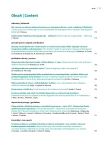The Scottish model of vancomycin dosing and therapeutic drug monitoring improves both efficacy and safety of vancomycin therapy
Authors:
Kristýna Zahálková 1; Aleš Chrdle 1,5; Olga Dvořáčková 2; Marie Kašparová 3; Magdalena Horníková 4; Václav Chmelík 1
Authors‘ workplace:
Infekční oddělení Nemocnice České Budějovice, a. s.
1; Ústav laboratorní diagnostiky a veřejného zdraví Zdravotně sociální fakulty Jihočeské univerzity v Českých Budějovicích
2; Laboratoř klinické chemie, hematologie a imunologie Nemocnice České Budějovice, a. s.
3; Pracoviště bakteriologie Laboratoře lékařské mikrobiologie Nemocnice České Budějovice, a. s.
4; Tropical and Infectious Disease Unit, Royal Liverpool University Hospital, Liverpool, Velká Británie
5
Published in:
Vnitř Lék 2018; 64(7-8): 717-724
Category:
Original Contributions
Overview
Objective: Vancomycin therapeutic drug monitoring (TDM) is recommended for better treatment efficacy and safety. The Scottish Antimicrobial Prescribing Group model recommends weight-based loading dose, next 3–4 doses based on creatinine clearance and maintenance doses according to trough concentrations. Methods: Retrospective cohort study of all adult patients treated with vancomycin before and after introducing the guideline in a large Czech hospital in 2015 compares the success rate in achieving recommended trough concentrations (10–20 mg/l) during first measurement and efficiency of maintaining these concentrations subsequently. Assessment of vancomycin related nephrotoxicity is included. Results: In 2014, 74/163 (45.4 %) patients achieved recommended concentrations in the first measurement, compared to 101/160 (63.1 %) patients in 2016 (χ2; p = 0.001). Recommended trough concentrations in more than half of subsequent measurements were detected in 51/105 patients (48.6 %) in 2014 and in 80/117 patients (68.4 %) in 2016. Not a single level in subsequent measurements within the range was detected in 28 (26.7 %) cases in 2014 and in 10 (8.5 %) cases in 2016 (Mann-Whitney; p = 0.026). There was no difference in nephropathy occurrence (χ2; p = 0.286). Conclusion: The adopted Scottish model of vancomycin TDM resulted in very significantly higher achievement of recommended trough concentrations during first measurements and significantly more effective maintenance of subsequent concentrations, without increased nephrotoxicity. Key words: guideline – therapeutic drug monitoring – vancomycin
Sources
1. Martínková J. Současný náhled na vankomycin v léčbě infekcí vyvolaných stafylokokem rezistentním na methicilin (MRSA). Klini Mikrobiol Inf Lék 2015; 21(1): 16–23. 2. Sinha RA, Haikal A, Hammoud KA et al. Vancomycin and the Risk of AKI: A Systematic Review and Meta-Analysis. Clin J Am Soc Nephrol 2016; 11(12): 2132–2140. Dostupné z DOI: . 3. Kacířová I, Grundmann M. TDM antibiotik v klinické praxi. Kardiol Rev Int Med 2015; 17(1): 57–64. 4. Štěpán M, Chytra M, Pelnář P et al. Kontinuální versus intermitentní podání vankomycinu u grampozitivních infekcí rezistentních na beta-laktamová antibiotika u nemocných v intenzivní péči. Anest intenziv Med 2009; 20(6): 309–316. 5. Brown ML, Hutchison AM, McAtee AM et al. Allometric versus consensus guideline dosing in achieving target vancomycin trough concentrations. Am J Health Syst Pharm 2017; 74(14):1067–1075. Dostupné z DOI: . 6. Tongsai S, Koomanachai P. The safety and efficacy of high versus low vancomycin trough levels in the treatment of patients with infections caused by methicillin-resistant Staphylococcus aureus: a meta-analysis. BMC Research Notes 2016; 9(1): 455. Dostupné z DOI: . 7. Kacířová I, Grundmann M. Terapeutické monitorování vankomycinu v rutinní klinické praxi. Vnitř Lék 2014; 60(10): 846–851. 8. Holmes NE, Turnidge JD, Munckhof WJ et al. Vancomycin AUC/MIC Ratio and 30-Day Mortality in Patients with Staphylococcus aureus Bacteremia. Antimicrob Agents Chemother 2013; 57(4): 1654–1663. Dostupné z DOI: . 9. Liu C, Bayer A, Cosgrove SE et al. Clinical practice guidelines by the Infectious Diseases Society of America for the treatment of methicillin-resistant Staphylococcus aureus infections in adults and children. Clin Infect Dis 2011; 52(3): e18-e55. Dostupné z DOI: . 10. Bakke V, Sporsem H, Von der Lippe E et al. Vancomycin levels are frequently subtherapeutic in critically ill patients: a prospective observational study. Acta Anaesthesiol Scand 2017; 61(6): 627–635. Dostupné z DOI: . 11. Scottish Antimicrobial Prescribing Group Guidance. Dostupné z WWW: . 12. Chrdle A, Horníková M, Pešková M. Doporučený postup parenterálního dávkování vankomycinu v Nemocnici České Budějovice. Nemocnice České Budějovice, a.s. NCB_SOP_L_13_008_A, verze 1.7.2015. 13. Ploessl C, White C, Manasco K. Correlation of a Vancomycin Pharmacokinetic Model and Trough Serum Concentrations in Pediatric Patients. Pediatr Infect Dis J 2015; 34(10): e244-e247. Dostupné z DOI: . 14. Kishk OA, Lardieri AB, Heil EL et al. Vancomycin AUC/MIC and Corresponding Troughs in a Pediatric Population. J Pediatr Pharmacol Ther 2017; 22(1): 41–47. Dostupné z DOI: . 15. Rybak MJ, Lomaestro BM, Rotschafer JC et al. Therapeutic monitoring of vancomycin in adults summary of consensus recommendations from the American Society of Health-System Pharmacists, the Infectious Diseases Society of America, and the Society of Infectious Diseases Pharmacists. Pharmacotherapy 2009; 29(11): 1275–1279. 16. Sutton JD, Mynatt RP, Kaye KS et al. Nephrotoxicity Comparison of Two Commercially Available Generic Vancomycin Products. Antimicrob Agents Chemother 2015; 59(9): 5470–5474. Dostupné z DOI: . 17. Pereira M, Rodrigues N, Godinho I et al. Acute kidney injury in patients with severe sepsis or septic shock: a comparison between the “Risk, Injury, Failure, Loss of kidney function, End-stage kidney disease” (RIFLE), Acute Kidney Injury Network (AKIN) and Kidney Disease: Improving Global Outcomes (KDIGO) classifications. Clin Kidney J 2017; 10(3): 332–340. Dostupné z DOI: . 18. Suchánková H, Machačová M, Herodesová T. Terapeutické monitorování vankomycinu v klinické praxi. Klin Farmakol Farm 2016; 30(2): 4–8. 19. Bond SE, Crowther SP, Adhikari S et al. Design and Implementation of a Novel Web-Based E-Learning Tool for Education of Health Professionals on the Antibiotic Vancomycin. J Med Internet Res 2017; 19(3): e93. Dostupné z DOI: .
Labels
Diabetology Endocrinology Internal medicineArticle was published in
Internal Medicine

2018 Issue 7-8
Most read in this issue
- Low-carbohydrate diet in diabetes mellitus treatment
- Spironolactone in the treatment of hypertension: a neglected molecule
- Mesenchymal stem cells and type 1 diabetes treatment
- Controversies in the treatment of gout
